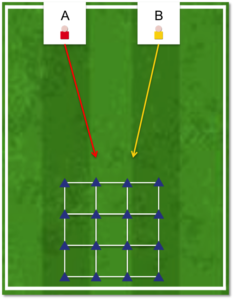Menu
METHOD
After numerous experiences across various youth categories and countless exchanges during various updating courses, today the technical sector is setting a methodological training guideline heavily based on researching the individual athlete’s characteristics to develop and nurture them, eventually expanding their capacity not just as individuals, but as a team. Current statistics highlight the need to rediscover the qualities and abilities of one-on-one duels, the cleverness in creating space, and the creativity in using feints to gain numerical superiority. For too long, perhaps, the pure zonal schematizations have somewhat standardized the various movements of the game units as well as the individual players’ performances. Personally, I believe in planning a mixed technical approach, not only focused on maintaining the zones covered by the units but also emphasizing individual field invasion, thus seeking one-on-one or two-on-two duels, etc., to inevitably enhance the players’ technical abilities and tactical decision-making. Today, the technical sector assists us with simple yet extremely effective notions, especially regarding marking and defensive skills. For too long, marking, covering, and positioning may have been interpreted exclusively as collective responsibilities. However, now, observing the levels of football in general, the responsibility should revert to being individual, aimed at disciplining and fostering the growth of the young footballer. The indicative formation at Coverciano is the 3-4-3 (three diamonds three), where we find the attacking midfielder (the ‘trequartista’) and the organization of chains and functional units. I believe it’s a proper and well-suited choice to rediscover a qualitative level of play from the lowest to the highest category.







